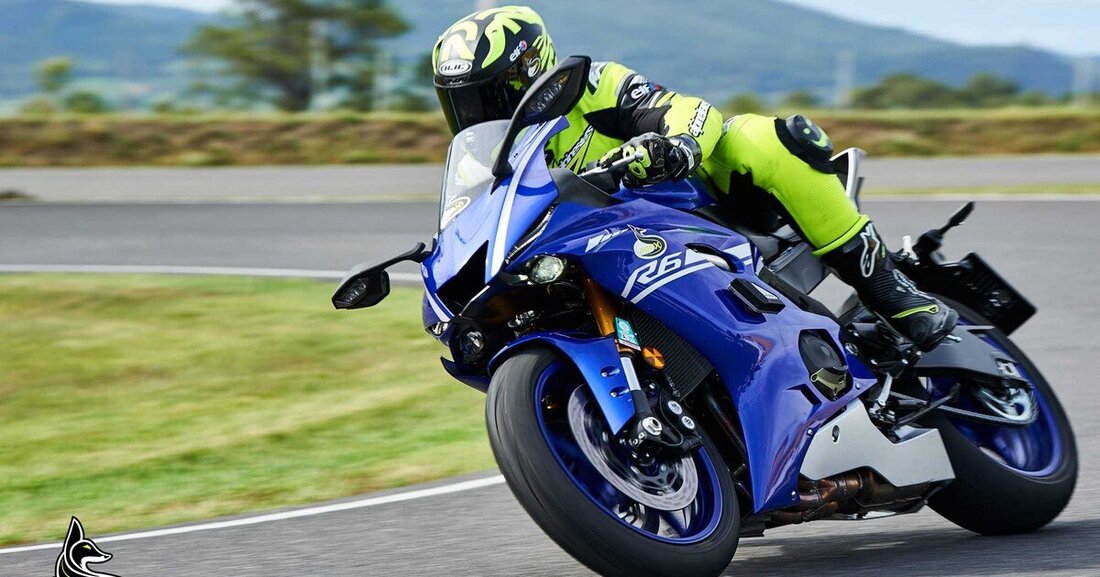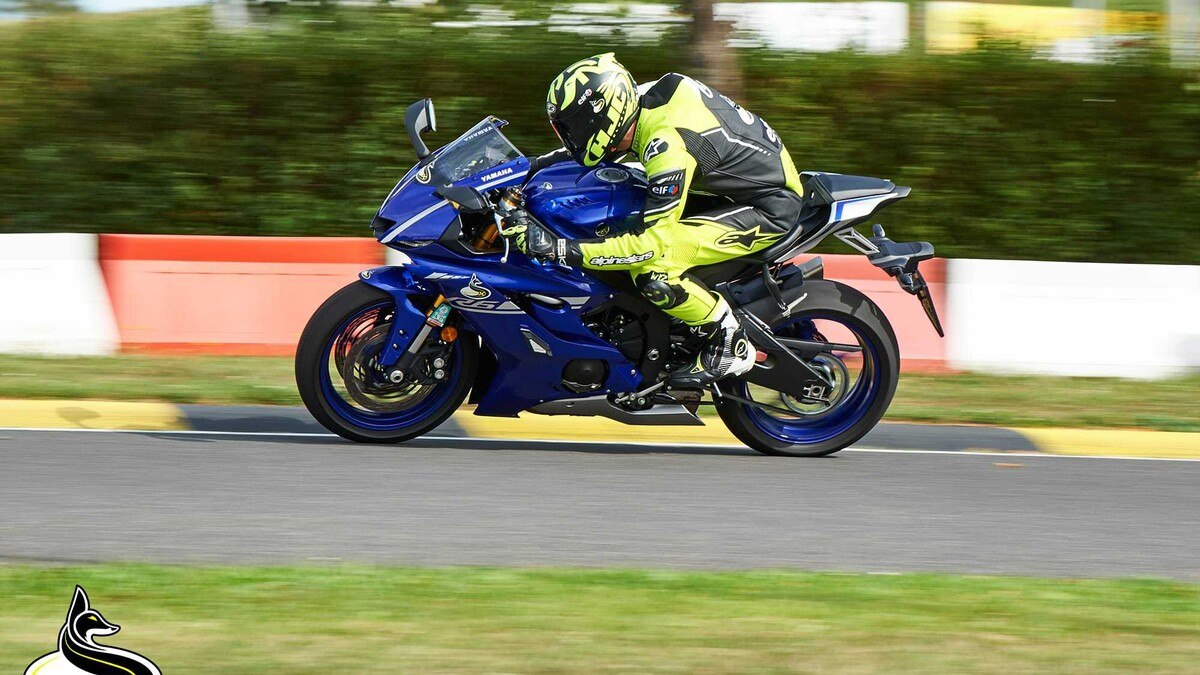Test Yamaha YZF-R6 2017 - Rossi's razor
The Yamaha R6 has dominated the world's race tracks for a decade. In the Supersport class up to 600 cubic meters there is hardly any way around it. The new edition of the super athlete comes with less performance but a full-bodied promise.

Test Yamaha YZF-R6 2017 - Rossi's razor
ergonomics
The 600 class has a reputation: they are the most uncompromising two-wheelers after trial bikes. Yes, the R6 has a pillion cushion and passenger footrests. But honestly, you don't even want to take your cheating ex-girlfriend with you for even five meters on the mini seat. The driver's seat position is all the more surprising: Of course, the monkey-at-the-grindstone attitude is the order of the day, but less uncompromising than expected. The stubs are deep, but Italian athletes would have mounted them lower. The tank is relatively flat and low, the seat height is generous at 850 millimeters, but feels lower due to the narrow saddle. When you first tackle corners, you immediately feel that there is plenty of lean angle. If you're not already driving quickly around the corner, it takes a lot of mobility in your limbs to drag your knee across the asphalt. The Suzuki GSX-R 1000 seemed to me to be more uncompromising when it came to ergonomics. Please don't misunderstand: the R6 is a thoroughbred athlete with just such a seating position, but despite my 1.85 meter body length, I was able to sit fairly humanely. The knee angle is right and the footrest position was almost optimal for me. In heavy pusher mode they could perhaps be a little further back, but that's certainly a matter of taste. Yamaha states that the R6 weighs 190 kilograms when ready to ride. We only measured 178 kilograms, fresh from the gas station, full to the brim, including crash pads (more on that later) and Akrapovic slip-on. That's 12 kilograms below the factory specification. And yes, it feels as easy as it sounds. Fighting class: Flyweight. Cool, very cool.
Handling
It's no coincidence that Valentino Rossi uses Yamaha R6 and R1 bikes for track days as part of his VR46 Academy. Only the Japanese engineers will know how much influence the doctor had in the development. The fact is: the handling of the new R6 is razor-sharp. The front wheel feedback is excellent, which - in my opinion - is unique in the super sports class. The connection to the front wheel is wonderfully transparent. If you accelerate and increase the lean angle, the R6 becomes even more precise and gives the pilot exactly the confidence from the front wheel that is necessary to file the next tenths per lap with a broad, confident chest. Of course, the rear itself also steers and cannot be disturbed, but this is not too difficult due to the low torque. Whether closing dog curves, chicanes or high-speed corners, the R6 moves through the radii with absolute confidence and confidence. Even when braking sharply, the rear does not become excessively light but remains on the ground for a long time and ensures sufficient steering stability. Overall, the handling is as easy and precise as you would expect from the queen of the super sports class. Criticism? Sorry, I really can't comment. The R6 stands out in the handling rating.
Engine/gearbox
It is unusual for a new model to have less power than its predecessor. With the R6 it is a fact and is due to the Euro 4 emissions standard. The in-line four-cylinder produces 118.4 hp (at 14,500 rpm) and 61.7 Nm (at 10,500 rpm) from 599 cubic meters. Performance information that is relatively unspectacular. Euphoria or excitement while reading? Zero for me. Fortunately, driving experience counts. And I'm still unsure about that. Typically a 600 R4 engine needs speed to move. The ride begins at just under 2000 tours. Flowing in city traffic is relaxed between 4000 and 5000 tours. From around 7,500 tours onwards things start to progress in a sporty way. When cornering ambitiously, the needle should not drop below 8,000 rpm and upshifts at 15,000 at the latest. Above that (red area at almost 17,000 revolutions!) there is no more emphasis. In order to keep the R6 lively, you need a nimble left foot. The transmission shifts perfectly, smoothly and precisely. And if you want to move forward without interruption and load correctly, then the Quickshifter is used. A short tap on the gear lever, amazed, the next higher gear has changed almost imperceptibly. Stunned! Stunned! The Quickschifter is a dream. Plus the sonorous, quite loud sound from the airbox. Splendid. Subjectively great cinema. Above all, the hotter screaming from the pretty Akrapovic pot is a turn-on. But the speedometer simply doesn't move as fast as the tachometer. Even on the highway you have to fire up a lot to blow away swanky GTIs and the like. No matter how snotty and cheeky the little screamer between his thighs may be, just under 120 hp isn't that much anymore. The low torque in particular is a problem for the R6 in everyday life, and the low torque is painful. But: The R6 is homologated as a street motorcycle, but in reality it is a thoroughbred basis for racetrack drivers. And nothing else. And on the world's racetracks, torque in the lower and middle speed ranges is nice, but is best used for relaxed pit drives. Hence my personal conflict: Actually, the engine is too weak for me due to the low torque on the road and in everyday life. On the other hand, it is not designed for that, but for top-end power on the race track, where noise and emissions regulations are practically abolished. And then the performance is right, even if you soon feel that the predecessor produced a little more bang. What is fantastic, however, is the direct, very soft throttle response and the superb anti-hopping clutch. The tail only stops if you stab the radius really badly and turn off your brain completely.
Undercarriage
May I introduce: Miss Front Wheel Confidence. Its low weight, sophisticated geometry and perfectly functioning fork allow the R6 to maneuver so sharply that after just a few corners you are one with the front wheel. You can change radii with the Japanese in a handy, neutral way. As the speed increases, their stability also increases. In slow corners it is pleasantly handy, in faster corners it becomes noticeably more stable without appearing sluggish. The Yamaha engineers have achieved excellent coordination here. Very big cinema. Only very hard load changes - such as abruptly turning off the gas tap at the apex of the curve - cause the R6 to experience minimal unrest. But even then it is wonderfully easy to conduct; line corrections are child's play regardless of the tilt. Personally, I think it's mainly due to the fork setup, as you feel like you're riding directly on the damping from the first few millimeters. No suspension travel is wasted without compromising on ride comfort. Both hard, short impacts (manhole covers) and flat, long asphalt waves are pushed away without oscillation or stubborn response. This fork performance from a production bike really impressed me. That's why I'll keep it short now: Chassis - exemplary.
Brakes
Yamaha's R6 and R1 have been known for years for delivering very good standard brakes. The new R6 continues the tradition. The front wheel brake only needs the minimum amount of lever travel and decelerates brilliantly from the first bite of the pad into the 320 millimeter double disc. The pressure point is as hard as Krupp steel. For me personally, the lever travel could be a little longer, as the controllability is somewhat compromised. It takes a lot of feeling in the right index finger to be able to apply the full braking power within the few millimeters of travel. Fortunately, the ABS intervenes reliably if you anchor a little too enthusiastically. The rear wheel brake can be adjusted perfectly, but the braking effect is only normal and not as brutally violent as that of the front stoppers. In city traffic I almost exclusively used the rear brake.
Noticed
The not-so-compromising seating position, its high susceptibility to wind from the side (I suspect because of the low weight), the good sound and the perfect arrangement of the crash pads. An accident does not end with a scratched panel and broken levers, but only with scratches on the crash pads and the exhaust cover. Unfortunately, I tried it out, so I can with the best of my knowledge and belief strongly recommend that every R6 driver get the pads from Yamaha. You save money and the look is very unobtrusive. The quickshifter is mandatory and works perfectly.
Failed
Failure is an exaggeration, but the really low torque doesn't suit me on the 16,000 euro bike. A fuel gauge would also have been nice.
Test verdict: Yamaha R6, by p.bednar
More information about Yamaha R6
With kind support from TOTAL Austria
More action photos from the test drives can be found on Instagram: apex_moto_at
Or follow us on Facebook: Apex Moto

 Suche
Suche
 Mein Konto
Mein Konto




















